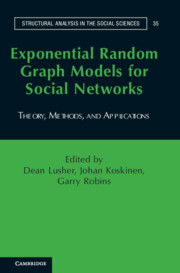Book contents
- Frontmatter
- Contents
- List of Figures
- List of Tables
- 1 Introduction
- Section I Rationale
- Section II Methods
- Section III Applications
- 14 Personal Attitudes, Perceived Attitudes, and Social Structures: A Social Selection Model
- 15 How To Close a Hole: Exploring Alternative Closure Mechanisms in Interorganizational Networks
- 16 Interdependencies between Working Relations: Multivariate ERGMs for Advice and Satisfaction
- 17 Brain, Brawn, or Optimism? Structure and Correlates of Emergent Military Leadership
- 18 Autologistic Actor Attribute Model Analysis of Unemployment: Dual Importance of Who You Know and Where You Live
- 19 Longitudinal Changes in Face-to-Face and Text Message–Mediated Friendship Networks
- Chapter 20 Differential Impact of Directors’ Social and Financial Capital on Corporate Interlock Formation
- 21 Comparing Networks: Structural Correspondence between Behavioral and Recall Networks
- Section IV Future
- References
- Index
- Name Index
18 - Autologistic Actor Attribute Model Analysis of Unemployment: Dual Importance of Who You Know and Where You Live
Published online by Cambridge University Press: 05 April 2013
- Frontmatter
- Contents
- List of Figures
- List of Tables
- 1 Introduction
- Section I Rationale
- Section II Methods
- Section III Applications
- 14 Personal Attitudes, Perceived Attitudes, and Social Structures: A Social Selection Model
- 15 How To Close a Hole: Exploring Alternative Closure Mechanisms in Interorganizational Networks
- 16 Interdependencies between Working Relations: Multivariate ERGMs for Advice and Satisfaction
- 17 Brain, Brawn, or Optimism? Structure and Correlates of Emergent Military Leadership
- 18 Autologistic Actor Attribute Model Analysis of Unemployment: Dual Importance of Who You Know and Where You Live
- 19 Longitudinal Changes in Face-to-Face and Text Message–Mediated Friendship Networks
- Chapter 20 Differential Impact of Directors’ Social and Financial Capital on Corporate Interlock Formation
- 21 Comparing Networks: Structural Correspondence between Behavioral and Recall Networks
- Section IV Future
- References
- Index
- Name Index
Summary
Unemployment: Location and Connections
Persistent regional unemployment disparities have been characterized as a major cause of regional decay and impose significant costs on communities (Bill, 2005; Mitchell & Bill, 2004). Macroeconomic explanations for the persistence of unemployment often revolve around economic factors, including spatial changes in the skill requirements of jobs, migration of jobs to the suburbs, persistent demand constraints, wage differentials, low labor mobility and related structural impediments, and variations in the distribution of industries across space (see reviews, for example, in Ihlanfeldt and Sjoquist (1998) and Ramakrishnan and Cerisola (2004)). Outside traditional macroeconomic explanations of unemployment at the local area level (e.g., suburb), explanations draw on theories of residential segregation (Cheshire, Monastiriotis, & Sheppard, 2003; Hunter, 1996), which suggest that similar educational background and socioeconomic status along with housing market factors play a substantial role in determining how people are distributed across geographic space. Over time, these differences may become more pronounced as people sort further along lines of race and income (Bill, 2005). Cheshire et al. argued that where people live does not drive inequality but rather determines geographic location of inequality:
Where people live and the incidence of segregation and ultimately of exclusion, mainly reflects the increasing inequality of incomes. So if either the incidence of unemployment rises and/or if the distribution of earning becomes more unequal then social segregation intensifies…the poor are not poor, isolated and excluded for the reason which makes them poor. They are not poor because of where they live; rather they live where they do because they are poor. (2003, 83–84)
- Type
- Chapter
- Information
- Exponential Random Graph Models for Social NetworksTheory, Methods, and Applications, pp. 237 - 247Publisher: Cambridge University PressPrint publication year: 2012
- 1
- Cited by

